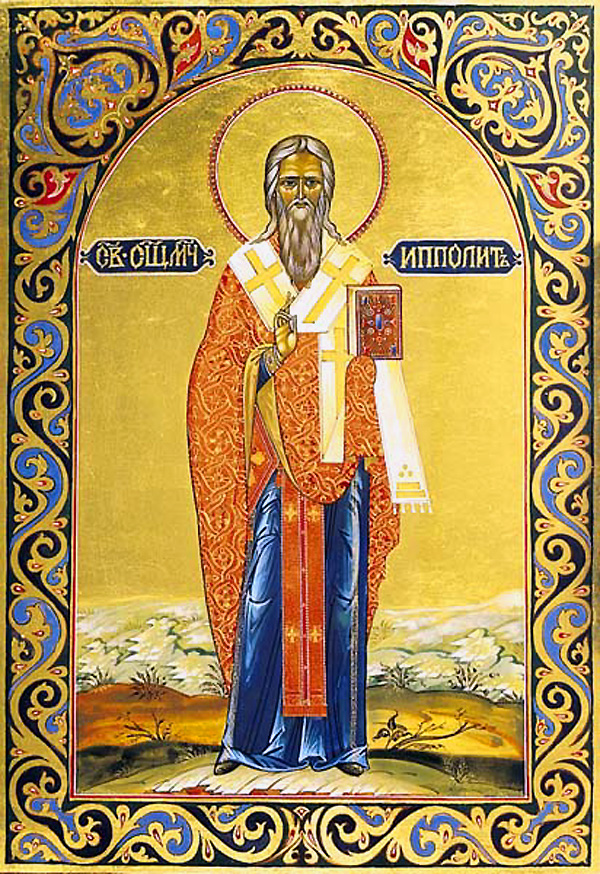Liturgical Development

Writings also exist from the third century which give many insights into the canonical and liturgical life of the Church in this era. These are the so-called Teachings of the Apostles from Syria, and the Apostolic Tradition of Saint Hippolytus of Rome, the last Church leader in the West who wrote in Greek. The former gives regulations concerning the hierarchical offices and the sacramental practices in the Church of Syria, and it describes the liturgical assembly. The latter gives similar information, in a more lengthy and detailed way, about the Church in Rome—though it probably also reflects influence from Alexandria. It contains the text of the oldest fixed Eucharistic prayer in Church history that we possess, as well as the form for the sacraments of Baptism, Chrismation, and Ordination.
Baptism and Chrismation in the
Apostolic Tradition of Hippolytus
And when he who is to be baptized goes down to the water, let him who baptizes lay a hand on him, saying thus: “Dost thou believe in God the Father Almighty?”
And he who is being baptized shall say: “I believe.”
Let him forthwith baptize him once, having laid his hand upon his head. And after this, let him say: “Dost thou believe in Jesus Christ, the Son of God, Who was born of the Holy Spirit and the Virgin Mary, Who was crucified in the days of Pontius Pilate; and died and was buried; and He rose the third day living from the dead; and ascended into heaven; and sat down at the right hand of the Father; and will come to judge the living and the dead?”
And when he says: “I believe,” let him baptize him the second time.
And again let him say:
“Dost thou believe in the Holy Spirit in the Holy Church, and the resurrection of the flesh?”
And he who is being baptized shall say: “I believe.”
And so let him baptize him the third time.
And afterwards when he comes up from the water, he shall be anointed by the presbyter with the Oil of Thanksgiving, saying:
“I anoint thee with holy oil in the Name of Jesus Christ.”
And so each one drying himself with a towel, they shall now put on their clothes, and after this let them be together in the assembly (Church).
And the Bishop shall lay his hand upon them, invoking and saying:
“O Lord God, who didst count these Thy servants worthy of deserving the forgiveness of sins by the laver of regeneration, make them worthy to be filled with Thy Holy Spirit and send upon them Thy grace, that they may serve Thee according to Thy will, for to Thee is the glory, to the Father and to the Son with the Holy Spirit in the Holy Church, both now and ever and world without end. Amen.”
After this, pouring the consecrated oil from his hand and laying his hand on his head, he shall say:
“I anoint thee with holy oil in God the Father Almighty and Christ Jesus and the Holy Spirit.”
And sealing him on the forehead, he shall give him the kiss of peace and say: “The Lord be with you.”
And he who has been sealed shall say: “And with thy spirit.”
And so he shall do to each one severally.
Thenceforward they shall pray together with all the people. But they shall not previously pray with the faithful before they have undergone all these things.
And after the prayers, let them give the kiss of peace.
Eucharist in the Apostolic Tradition of Hippolytus
Celebrant: “The Lord be with you.”
People: “And with thy spirit.”
Celebrant: “Lift up your hearts.”
People: “We have them in the Lord.”
Celebrant: “Let us give thanks to the Lord.”
People: “That is proper and right.”
Celebrant: “We thank Thee God through Thy beloved servant Jesus Christ Whom Thou hast sent in the latter times to be our Savior and Redeemer and the messenger of Thy counsel, the Logos Who went out from Thee, through Whom Thou hast created all things, Whom Thou wast pleased to send out from heaven into the womb of the Virgin, and in her body He became incarnate and was shown to be Thy Son born of the Holy Spirit and of the Virgin. In order to fulfill Thy will and to make ready for Thee a holy people, He spread out His hands when He suffered in order that He might free from sufferings those who have reached faith in Thee.
“And when He gave Himself over to voluntary suffering, in order to destroy death, and to break the bonds of the devil, and to tread down hell, and to illuminate the righteous, and to set up the boundary stone, and to reveal the Resurrection, He took bread, gave thanks, and said: ‘Take, eat, this is My body which is broken for you.’ In the same manner also He took the cup, and said: ‘This is My blood which is poured out for you. As often as you do this you keep My memory.’
“When we remember His death and His resurrection in this way, we bring to Thee the bread and the cup, and give thanks to Thee, because Thou hast thought us worthy to stand before Thee and to serve Thee as priests.
“And we beseech Thee that Thou wouldst send down Thy Holy Spirit on the sacrifice of the Church. Unite them, and grant to all the saints who partake in the sacrifice, that they may be filled with the Holy Spirit, that they may be strengthened in faith in the truth, in order that we may praise and laud Thee through Thy servant, Jesus Christ, through Whom praise and honor be to Thee in Thy Holy Church now and forevermore. Amen.”
